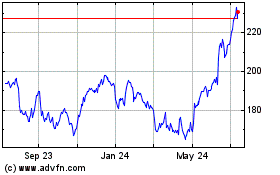Apple Powers Up by Pricing Down -- Heard on the Street
April 15 2020 - 1:33PM
Dow Jones News
By Dan Gallagher
Apple Inc. finally got around to updating the iPhone SE. And not
a moment too soon.
The new iPhone SE was announced Wednesday -- just a little over
four years since the company unveiled the first version. That first
phone represented a departure from Apple's modus operandi, in the
sense that it offered top-of-the-line performance in a smaller and
cheaper design. The new phone adheres to that same idea, offering
the same A13 processor that powers Apple's iPhone 11 family at a
starting price of $399 -- 43% below the starting price of the base
iPhone 11 model.
That should appeal to buyers who can't stomach smartphone prices
now commonly reaching well above $1,000. And there are a lot more
of those lately. In America alone, nearly 17 million have hit the
unemployment lines in just the past three weeks. The coming global
recession also sets a poor stage for Apple's reported plans to
launch its first 5G devices this fall.
And unlike in the last recession, when Apple successfully
launched its very first iPhone, smartphones are now a practical
necessity for working adults and students alike. Apple is right to
cater to a wider swath of customers -- even if a lower-priced phone
doesn't boost the company's sales to the same degree. The last
iPhone SE sold just under 50 million units between Apple's 2016 and
2018 fiscal years before it was taken off the market, according to
consensus analyst estimates from Visible Alpha. That's a little
less than 8% of total iPhone units sold in that time.
A cheaper iPhone serves Apple's interests in other ways, too.
The new SE model replaces the iPhone 8 family, effectively dropping
the two-and-a-half-year-old A11 processor from the iPhone lineup
and shifting a larger proportion of the installed base to the more
robust A12 and A13 chips. Newer processors offer better performance
for the apps and services that Apple now counts as its
second-largest business segment and main driver of growth. Taking
less up front makes Apple's service upsell go down a little
easier.
Write to Dan Gallagher at dan.gallagher@wsj.com
(END) Dow Jones Newswires
April 15, 2020 13:18 ET (17:18 GMT)
Copyright (c) 2020 Dow Jones & Company, Inc.
Apple (NASDAQ:AAPL)
Historical Stock Chart
From Mar 2024 to Apr 2024

Apple (NASDAQ:AAPL)
Historical Stock Chart
From Apr 2023 to Apr 2024
